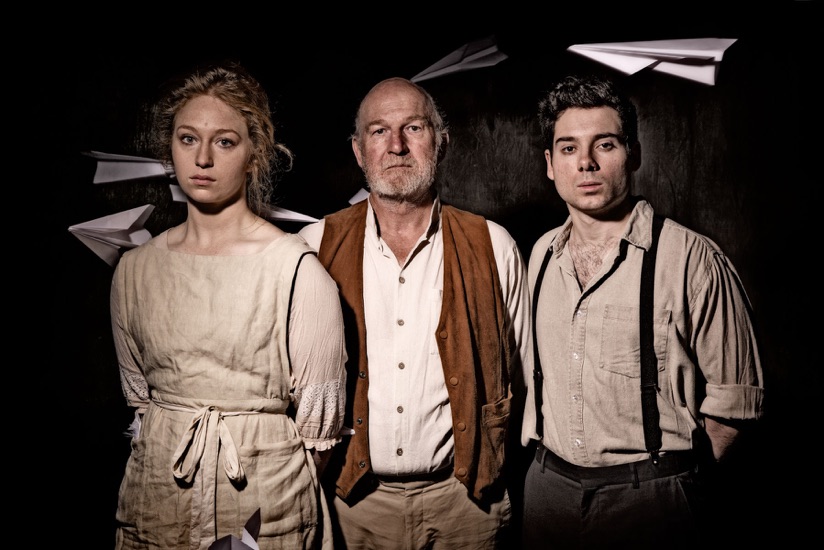Here is the third and final part of We are the Ghosts of the Future actor Darcy Brown's diary.
Biggles
Biggles
We are the Ghosts of
the Future contains several references to the fictional pilot and adventurer,
Biggles. An echo of the by-then mythic status of the recently vanished Charles
Kingsford Smith. Here are a few fascinating titbits about Biggles and The Cruise of the Condor, along with the colour plates and
illustrations featured in the first edition:
Images from: http://www.biggles.info/Details/02/
The second
Biggles adventure to be published, The
Cruise of the Condor appeared in 1933. Written by Captain W. E. Johns, a
former World War One pilot, the series about James Bigglesworth and his mates
Algy and Ginger eventually ran to almost a hundred volumes.
The Cruise of the Condor is Biggles on the trail of Inca
gold deep in the heart of the Amazon. Following a surprise visit to his Uncle Dickpa’s
house, Biggles and Algy find Dickpa held hostage by a group of thieves. Returning
with a rented aircraft, Biggles rescues his uncle, and together with Algy and
Flight Sergeant Smyth, they all travel to South America on a treasure hunt.
For Biggles fans ... When The Cruise of the Condor
was (re)printed in the Boys’ Friend Library in 1938, there was an additional
passage:
‘[Biggles]
dropped into a deck-chair and lit a cigarette. “I was only thinking of some of
the wonders we saw, and of those we did not see. There are a few. And, personally,
I want to have another go—I don’t know when, or how. It’s like having a magic
forest at the end of the garden with a fence placarded with notices,
‘verboten,’ ‘defense de passer’ all the lingos—don’t seem in nature to hold
back. And, what’s more to the point, I feel convinced in my own mind that,
apart from the beauty of it, the giddy transformation scenes of all the rainbow
hues, there’s locked up away there in those majestic vastnesses a something—a
something—”
“Yes,” murmured Dickpa eagerly, as he leaned forward, a new light
in his eyes ...
Biggles
flicked the ash off his cigarette. “I mean,” he said dreamily, “that there may
be something there which would act as the key to lots of our old problems—
something that’s been lost in the limbo of the past; something so much worth
having that even to dwell on it may well make one feel a bit squizzly about the
eyes. I mean something of splendour which was swept away when some of the
ancient civilisations went down to the dust. But ideas don’t perish, you know,
any more than thought itself. It is merely a matter of finding the way back and
retrieving the treasure, picking up a thread, as it were, resuming work on jobs
left unfinished by some of the grand old fellows who had made something of
their beautiful country and were doing very well.’
A Few Thoughts
The ‘Ghost Story’ feeling that runs through this; the
terrace house as time-machine, séance, memory palace, whatever. Spirit theatre
...
A wonderful thing about the promenade format is that so much
of the work of creating the world is facilitated, given ease, simply by the
audience inhabiting that shared space, and it not being one into which meaning
has to be projected (simple things: it’s a real house, it has a ready-made history, we
don’t have to imagine the Rocks outside, etc.) Instantly conjures atmosphere
and removes some of the imaginative gap between character and spectator. Its
tactile reality, and existing detail, provide an imaginative web.
Also just very, blackly, funny. Appeals to my morbid side.
Shades of The Innocents? Picnic at Hanging Rock? The War of the Buttons? David Lynch? Peter Pan? The Sound and the Fury? ...
Intensification of the theatrical exchange: repetitions, the
illusion of the first time, being everything. Actually, the illusion of the
first and only time. Here, opportunity
to change, experiment, respond uniquely, improvise, remake the piece anew
multiple times in a single evening! Monopolising on the intimacy of the ‘one
room’ circumstance ...
Permanence/Impermanence ...
‘It is not uncommon to still hear people express the view
that people with disability would be better off in institutions with other of
their own kind. There also appears to be a common belief that people with
disability are not able to make a significant contribution to the community.’
(Verick) Echoes/parallels the contribution of the artist?—fighting for the value of an artistic output, devotion of
one’s time to a creative pursuit; struggle for validation, comprehension ...
Seeing with ‘the eyes of a child’ a noble, miraculous thing ...
There are exciting possibilities for the presence of the
audience to be acknowledged and openly included in the scene. Bridget and Tommy
are not necessarily relegated or tied-down to the past, but rather able to
‘see’ these onlookers.
Alternate perceptions, the confusion between reality and
dreaming, time as one great continuous, looping design ...





















No comments:
Post a Comment